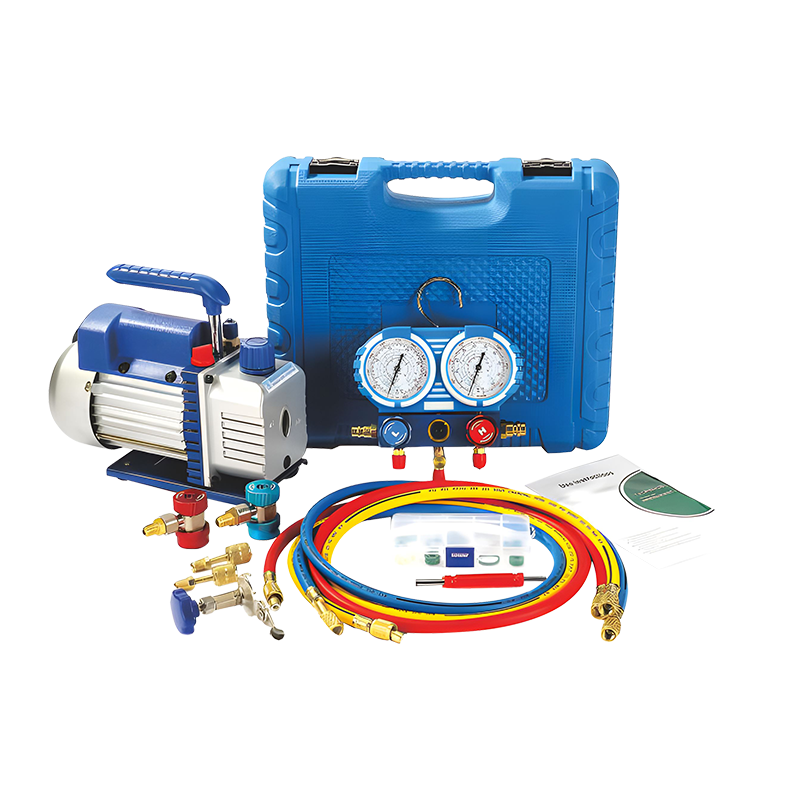Jul 04, 2025
In heating, ventilation, and air conditioning (HVAC) systems, proper maintenance and repair are essential for ensuring performance and longevity. Among the essential tools for HVAC technicians is the vacuum pump manifold gauge kit. This kit plays a critical role in system evacuation, pressure measurement, and leak detection. Understanding its components, functions, and proper usage is key to efficient HVAC servicing. This article offers a comprehensive introduction to the HVAC vacuum pump manifold gauge kit, explaining its design, applications, and practices.

The manifold gauge component provides precise pressure readings on both the high and low sides of the system, while the vacuum pump is used to create a deep vacuum to remove air and moisture.
A typical HVAC vacuum pump manifold gauge kit includes several essential parts:
Manifold Gauge Set: This consists of two pressure gauges, valves, and hoses. The gauges display high and low-pressure readings, while the valves control the flow of refrigerant or vacuum between the system and the pump.
Vacuum Pump: A device designed to evacuate air and moisture from the HVAC system. It creates a vacuum that helps remove non-condensable gases, ensuring the system operates efficiently.
Hoses: Typically, three hoses connect the manifold gauges to the system and vacuum pump. The hoses are color-coded—usually red for high pressure, blue for low pressure, and yellow for service or vacuum.
Accessories: Additional fittings, adapters, and carrying cases may be included to facilitate different HVAC system connections and ease of transport.
The vacuum pump manifold gauge kit operates by connecting the manifold gauges to the HVAC system's service ports. The technician then uses the vacuum pump to evacuate air, moisture, and contaminants from inside the system.
The manifold gauges provide real-time pressure readings during evacuation and recharging. The low-pressure gauge monitors the suction side, while the high-pressure gauge displays pressure on the discharge side. The valves on the manifold control the flow of refrigerant and vacuum, allowing precise manipulation during service.
Creating a vacuum is critical before adding refrigerant because any air or moisture in the system can inefficiency, corrosion, or damage.
The kit is indispensable in various HVAC tasks, such as:
System Evacuation: Removing air and moisture from new or repaired systems.
Leak Testing: Detecting leaks by monitoring pressure changes over time.
Charging Refrigerants: Accurately adding refrigerants after evacuation.
Pressure Diagnostics: Measuring operating pressures to troubleshoot system issues.
By enabling accurate pressure readings and efficient evacuation, the kit helps maintain system integrity and performance.
Utilizing this kit offers several benefits:
Precision and Accuracy: High-quality gauges provide reliable pressure measurements essential for proper system diagnosis and repair.
Comprehensive Functionality: Combining vacuum pumping and pressure measurement in one kit streamlines HVAC servicing.
Improved System Performance: Proper evacuation and charging extend system life and improve efficiency.
Ease of Use: Color-coded hoses and intuitive controls make the kit user-friendly for both novice and experienced technicians.
Durability: Many kits feature rugged construction and corrosion-resistant materials for long-lasting use.
Tips for Selecting the Right Kit
When choosing an HVAC vacuum pump manifold gauge kit, consider the following factors:
Gauge Accuracy: Look for gauges with clear, precise markings and durable construction.
Pump Capacity: Select a vacuum pump with sufficient power to achieve the desired vacuum level efficiently.
Hose Quality: Opt for flexible, reinforced hoses that resist kinking and wear.
Compatibility: Ensure the fittings and adapters match the types of refrigerants and system connections you work with.
Portability: A lightweight and compact kit is easier to transport and store.